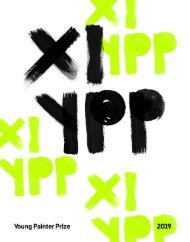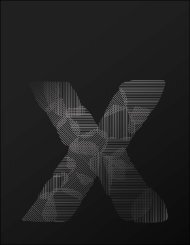XII Young Painter Prize Book
You also want an ePaper? Increase the reach of your titles
YUMPU automatically turns print PDFs into web optimized ePapers that Google loves.
pression, its projection into the near future,<br />
and the retention of the initial impression.<br />
We can observe that in the context of modernity,<br />
both the past and the future acquire<br />
meaning in the present. As Kristupas<br />
Sabolius observes, “in today’s art world a<br />
common element of uncertainty reveals<br />
both the impossibility of a homogeneous<br />
present and the postulation of the asynchrony<br />
of its different temporalities, while<br />
at the same time raising the problem of<br />
the nature of time itself” 4 .<br />
Let us recall the work of Andrius Zakarauskas<br />
– the first winner of the “<strong>Young</strong><br />
<strong>Painter</strong> <strong>Prize</strong>”. The issues of painting as<br />
a medium, painting as a gesture (paint,<br />
its application, bright stroke) and the author-artist’s<br />
self-representation (at the<br />
beginning of his career the artist often depicted<br />
his image on canvas) are important<br />
in his work. Since 2016 the artist’s paintings<br />
have displayed a new plastic expression<br />
that is characterised by an excess<br />
paint, splashing, pouring and embossing.<br />
The latter aspects are also reflected in<br />
the titles of his recent paintings, where the<br />
word “stroke” is dominant (visible stroke,<br />
larger stroke, third wave stroke, lip stroke,<br />
caring stroke, pleasant stroke, etc.). Time<br />
is one of the tools that allow us to interpret<br />
the materiality of colour in Zakarauskas’<br />
oeuvre. Such paintings as Lipstroke (2017)<br />
or Skinstroke (2016) function as an outline<br />
of a painting itself: a visible process, the<br />
traces of time, and behind-the-scenes<br />
creation – with the relief of the painting<br />
becoming equated with the stroke itself.<br />
The moment of the painter’s touch on the<br />
canvas is captured: the tactility of the<br />
work opens the viewer to the viewer, highlighting<br />
the elements of corporeality and<br />
ephemerality. The moment of the painter’s<br />
touch on the canvas is captured: the<br />
tactility of the work takes the gaze of the<br />
viewer to the past, highlighting the elements<br />
of corporeality and ephemerality.<br />
1 Claire Bishop, Radical Museology, London: Dan Perjovschi<br />
and Koenig <strong>Book</strong>s, 2013, p. 18.<br />
2 Boris Groys, „Comrades of Time”, in: E-flux journal, 2009,<br />
Nr. 1, http://www.e-flux.com/journal/11/.<br />
3 Saint Augustine, Confessions, Vilnius: Aidai, 2004, p. 281.<br />
4 https://artnews.lt/isivaizduojant-laika-39561





